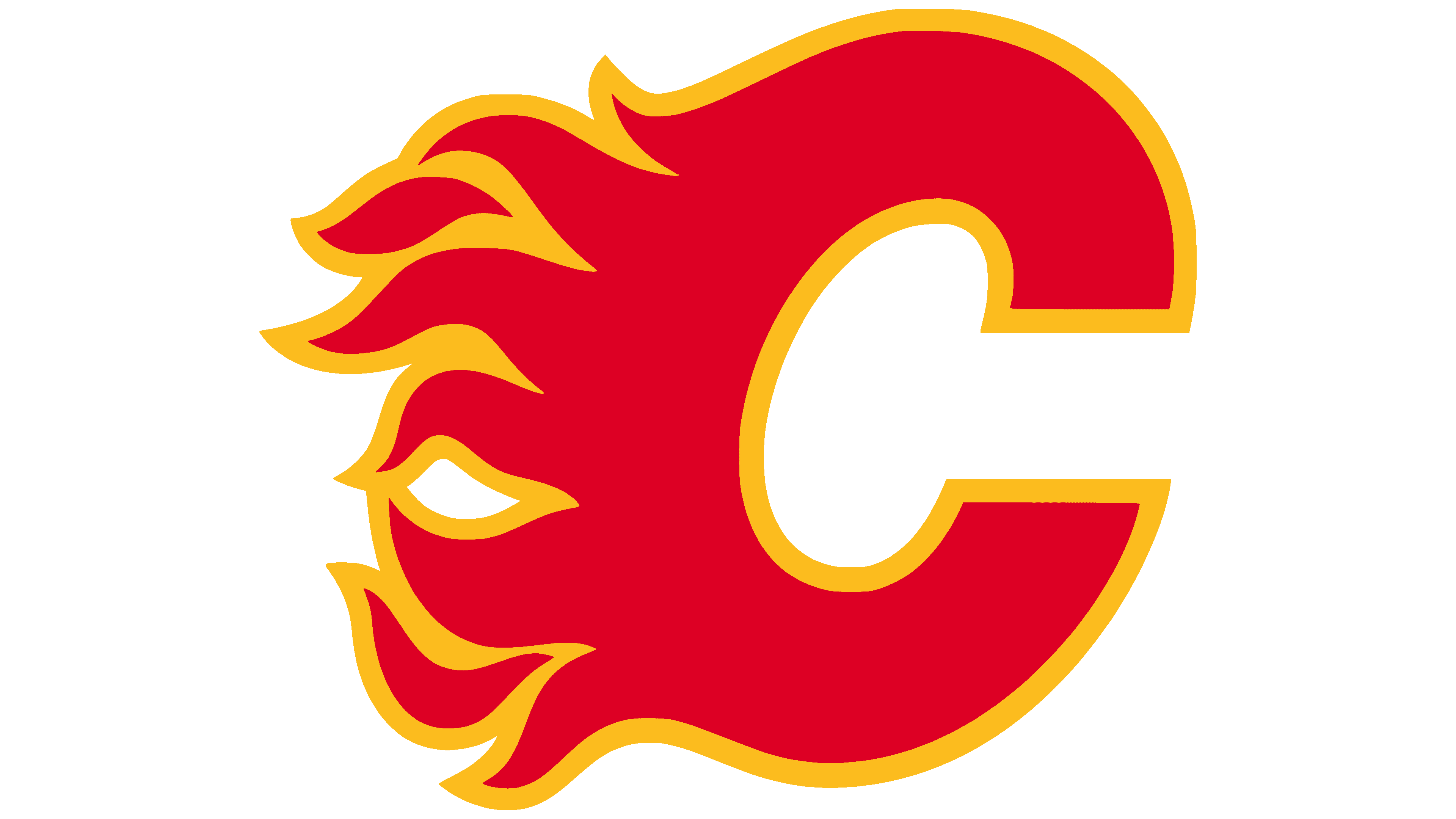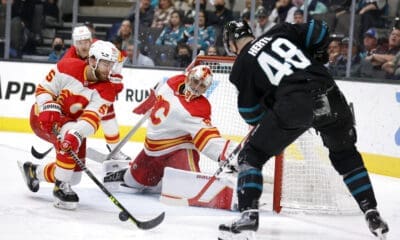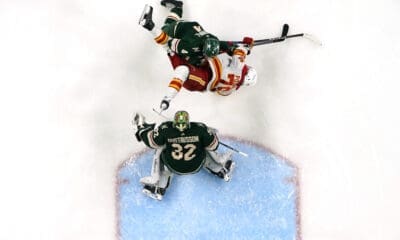Calgary Flames
Mikael Backlund – A Retrospective (Part 1 of 2)
"Smart and competitive two-way player" – Bob McKenzie on Backlund in 2007 when drafted. Let's take a look at the past, present, and future of Mikael Backlund. This is the first part of a two part examination at his past, present, and future; as well as a statistical look at his play.

I really dig Mikael Backlund. He’s arguably my favourite player on the team. I’ve always had incredible respect for the two-way centre; and frankly the two-way player in general. I’ve always had great admiration for the two-way players of the game from my generation like Jere Lehtinen, Sergei Fedorov, and Peter Forsberg. Is he in the same echelon as those guys? No, but he’s damn good.
The slow and gradual usage of Backlund has resulted in a very capable NHL forward utilized in all situations of the ice. You see him out there at even strength playing top competition. You see him out there on the penalty kill doing what it takes to prevent a power play goal. You see him out there on the power play trying to get things going. Finally, you see Mikael out there in crucial situations for the Flames.
His ability to impact and make players around him better and drive possession is something to take note of. His offensive game will probably never be what fans expected but his play outside of that is invaluable. It's been one of the bright spots over the last few seasons and something we should appreciate deeply. We'll touch more on the numbers in part two though.
Coming into this season (though it could have been done in the off-season), general manager Brad Treliving had two things to worry about: the contract extensions of TJ Brodie and Mikael Backlund. He’s dealt with one, now he needs to make sure Backlund is locked up for the immediate future.
Draft, Expectations, and Early Career
Backlund had a successful pre-draft year, being the Mac's Tournament MVP and scoring 31 points in the Swedish Superelite U-20 league in Sweden. An impressive showing definitely helped him achieve further success the next year.
During his draft year he played with a number of the Västerås clubs, including their U-18 team, junior team, and the big club. He was also part of the Swedish world junior U-18 team in which he potted six goals and an assist in six games. Sweden would finish fifth. Though he didn't have a huge volume of points to vault his draft stock, he was successful enough to be a projected first round guy.
Mikael was drafted 24th overall in 2007 in a draft that featured the talent of Patrick Kane, James Van Riemsdyk, Kyle Turris, Ryan McDonagh, and Logan Couture. With analysis projecting him as:
TSN ranked him 15th as their best available in 2007 on their rankings. The Flames were incredibly fortunate to get Backlund where they did. They swapped first-round picks with the St. Louis Blues allowing the Blues to draft Ian Cole (18th overall) and in return they received the 24th overall pick in the first round and a third round pick (which was used to draft John Negrin… who?).
While Hockey’s Future projected him to be a complete player with defensive skill, detractors at Dobber Sports noted his underwhelming campaign (after missing time with a knee injury) derailed his performance and didn’t land him a WJC roster spot (at age 17). Although, they agreed his skills in terms of vision, passing, and hands would be attributes of success for him.
That said, he would join the Swedish World Junior team twice in his eligibility. In 2008, he scored three goals and four assists in six games as he took home silver. He also scored this crucial goal to send Sweden to the final against Canada.
In 2009 he took home another silver with Sweden, finishing the tournament with five goals and two assists in six games.
Following that success he found himself joining the Kelowna Rockets in the WHL, scoring 12 goals and 18 assists in 28 GP. He would add three more goals in nine playoff games for them as well. He would suit up for one game as a 19 year old in the '08-09 season with the Flames. Kelowna went on to take the WHL championshig, too: beating Calgary in the final, four games to two.
His growth and evolution
The following season he joined the Flames' AHL affiliate in Abbotsford for his first season as a rookie scoring 15 goals and 17 assists in 54 GP for the Heat. He played 23 games in Calgary, scoring his first career goal and adding nine assists along the way. Continuing with his international experience he played for Team Sweden at the IIHF World Championships and earned a bronze medal.
Then '10-11 season was underwhelming for Mikael. 10 goals and 15 assists in 73 games including a stretch of games were he was a healthy scratch. It didn't bode well for the young Swede. The '11-12 season was no more enjoyable for him as injuries limited him to 41 GP and only a meagre 11 points. That said, he represented Sweden again and earned silver in the World Championships.
During the lockout, he played for his home club in Sweden, registering 12 goals and 18 assists in 23 GP. He returned to Calgary to play 32 games and register eight goals and eight assists in 16 GP. Overall it looked possible for him to trend upwards. The Flames also re-signed him in the summer of 2013 to a two year deal at $1.5M AAV.
Last season saw a real leap forward both on the ice with his play and the underlying side. A career high in points across the board: 18 goals, 21 assists for the young Swede. The reliance on playing him in some of the toughest situations was instrumental to much of the success last season. With the cluster of injuries to hit Team Sweden before Sochi, it was rumoured and openly discussed that he could represent his homeland; though it never happened he played for Sweden again in the World Championships earning a bronze medal with eight points in 10 GP, all the while wearing a letter.
His usage as a stop-gap for rookie Sean Monahan along with veteran Matt Stajan helped the Flames and their post-line brawl performance was noticeable. As he came into this season, fans definitely wanted to see if he could top a career year like last season. Injuries have derailed the first part of the season for him but he’s finding his game again.
Strengths and Weaknesses
The biggest detraction against Mikael Backlund is his offensive numbers and consistency. On the surface, before digging into it further, you see a guy putting up point totals in a bottom six capacity, which is fair assessment for fans and media. He's not going to score 60+ points probably but he's going to be a solid secondary contributor who is the focal point of an optimal shutdown line.
His shot isn't super flashy or scaring goalies, nor is he an imposing force in terms of hitting. You can make the case that he isn't big enough for the role he plays, but size is arbitrary and subjective.
His obvious strengths come with his hands, hockey IQ, skating, passing ability, and defensive skills. He's been known to show off his hands on the occasional breakaway and scoring chance. In terms of intelligence on the ice, he might be one of the smartest players for the Flames: able to find seams, enter the zone, and cautiously aware of what can happen.
His passing abilities have been heralded since he was drafted into the league. We may spend a lot of time admiring stretch passes or the flashy ones but Backlund working in tight areas and finding the passing lane is what he is best at. Defensively he's able to position himself appropriately with the play, read the situation, and provide suitable decision making that benefits Calgary.
We'll continue this analysis with an in-depth look at his value in terms of statistics and the impact he has on the team as well as a purely speculative approach at what he should be making/commanding during contract discussions.
by Mike Pfeil








